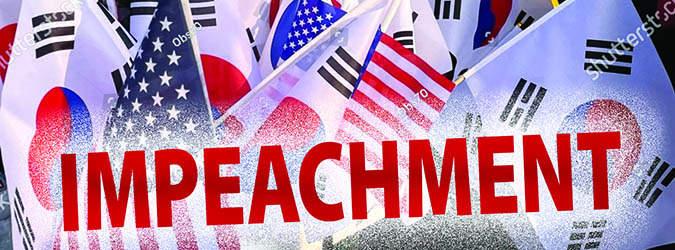Impeachment and the Constitution: South Korea and the United States
4.8.2025

The continuing travails of South Korean President Yoon Suk Yeol following his December 2024 declaration of martial law have presidential impeachment back on the front page, and if the Democrats retake the House of Representatives in 2026, we may hear about impeachment in the U.S. again as well. While impeachment is a common feature of presidential systems around the world, the black letter law of impeachment varies considerably from country to country, as does the way impeachment politics are actually carried out.[1]
South Korea and the U.S. are both presidential democracies, meaning that their presidents are elected for fixed terms to lead the executive branch and are not members of the legislature. This makes South Korea and the U.S. fundamentally different from parliamentary democracies, in which prime ministers, along with cabinet members, are elected to be members of parliament, which then appoints them to their positions leading the executive branch. Presidential democracies reject such responsibility of the executive to the legislative branch, typically opting instead for presidential impeachment as the way for the legislative branch to protect the country from presidential misbehavior. This article is intended to promote deeper understanding of presidential impeachment by highlighting important similarities and differences between the U.S. and South Korean systems in both law and practice.
Several key differences between the two systems arise in how impeachment actions originate and are adjudicated. In the U.S., impeachments originate in the House of Representatives, while South Korea gives that role to the National Assembly, its unicameral legislature. An interesting formal difference between the two is that the voting threshold in the U.S. House is much lower – a simple majority of the votes where an ordinary quorum is met[2] – while in South Korea a majority of the 300-member National Assembly must first vote to consider a presidential impeachment action, which must then be approved by two-thirds of the entire membership.[3] South Korea’s Democratic Party, which opposes President Yoon, controls roughly 180 seats in the National Assembly, so it was able to initiate an impeachment against Yoon on its own but needed some of Yoon’s party to defect in order to obtain the 200 votes required to impeach.[4] The fact that a two-thirds super majority is required in the National Assembly suggests that the drafters of the South Korean Constitution sought to put a damper on impeachment efforts, though as things have turned out, impeachment is not at all rare there.
Another important difference arising at the accusation stage has to do with effects. When the House votes to impeach a U.S. president or other officer, that person remains in office pending adjudication by the Senate, while in South Korea an official subject to a successful National Assembly impeachment vote must step aside pending the outcome of the impeachment adjudication by the Constitutional Court. While an impeachment action in the U.S. is definitely a distraction for the target, it has limited value as a general tool to hamstring the executive branch. In South Korea, however, it appears that impeachment may now be seen as an ordinary tool of “lawfare” against the executive branch when the president’s party is in the minority in the National Assembly. One of President Yoon’s justifications for declaring martial law has been that the Democratic Party had abused the impeachment process by bringing impeachment actions against more than 20 officials in his government, not for legitimate reasons but simply to harass his administration.[5]
Several other important differences arise in how South Korea and the U.S. adjudicate impeachment actions. In a nutshell, South Korea adopted a heavily legalized approach, leading to a certain set of challenges, while the U.S. adopted a more political approach, yielding its own problems. Turning first to South Korea, impeachment adjudications are assigned to its Constitutional Court, which must take up impeachment cases that have received the necessary 200 votes in the National Assembly.[6] The quorum requirement at the Constitutional Court for adjudicating presidential impeachments is seven of the nine justices, and if a quorum is met, at least six justices must vote in favor of impeachment.[7] When President Yoon’s impeachment reached the Constitutional Court, it had only six sitting justices because the National Assembly had failed to fill the three vacant seats due to partisan gridlock.[8] There was precedent suggesting that the Constitutional Court could rule on an impeachment with only six justices seated, and that precedent was actually based on a case brought by a member of Yoon’s own government who wanted to force the court to rule on her case because she had been suspended from office once the National Assembly impeached her.[9] Forcing the Senate to rule on one’s own impeachment would make no sense in the U.S. system, but, given South Korea’s rule to immediately suspend officials who have been impeached by the National Assembly, it would be very destabilizing if partisan gridlock in the National Assembly could render the Constitutional Court unable to rule on impeachment cases in a timely manner.
In President Yoon’s case, an additional issue arose because, as a legal matter, the president appoints to the court the justices who have been nominated by, in this case, the National Assembly, but by the time the National Assembly put forth candidates to fill the empty seats, President Yoon had already been impeached and suspended from his duties, and the prime minister was serving in his place. Sensing a loophole to exploit, some in Yoon’s party argued that an interim president/prime minister doesn’t inherit the full powers of a president who has been impeached, specifically the power to appoint justices to the court.[10] The point of that gambit seems to have been to delay the court from acting as long as possible. That would not have the effect of returning Yoon to office, but it would forestall the snap presidential election that must be held within 60 days after a president is convicted and removed by the Constitutional Court.[11] The Democratic Party, concerned that the first interim president/prime minister, Han Duk-soo, was acting too slowly in filling the vacant Constitutional Court seats, actually impeached him as well. As a result, presidential powers are currently being exercised by Han’s replacement, Finance Minister Choi Sang-mok.[12] Choi eventually appointed two new justices to the court, one nominated by the Democratic Party and one by Yoon’s People’s Power Party, so the quorum problem has been resolved for now, although legal sparring continues over filling the ninth seat that remains empty.[13]
Compared to the South Korean system, the U.S. approach to adjudicating impeachments is legally quite informal, most obviously because decision-making by the Senate could never replicate a properly functioning court. More specifically, the Senate, unlike South Korea’s Constitutional Court, is under no formal obligation to act on impeachments brought by the House, as demonstrated by its refusal to hear the January 2021 impeachment of President Trump.[14] In addition, the mainstream view in the U.S. is that the Supreme Court will not review impeachment decisions of the U.S. Senate, and that when the Supreme Court chief justice presides over presidential impeachment cases in the Senate, the chief justice serves basically a ceremonial role rather than actively presiding as a judge would over a trial. The fact that the Senate is made up of professional politicians acting outside the shadow of judicial oversight makes it unrealistic to expect a high degree of legality when the Senate rules on presidential impeachment.
Deepening the contrast between how the two systems adjudicate impeachments is a distinction in how they define an impeachable offense. The U.S. Constitution provides that the legitimate grounds for impeachment are “treason, bribery, or other high crimes and misdemeanors.”[15] Treason and bribery have relatively clear legal meanings, but “high crimes and misdemeanors,” a phrase borrowed by the Founding Fathers from English practice, is too vague to tightly constrain the House and the Senate. Discussions of the phrase by U.S. commentators often conclude that the phrase is best interpreted to capture presidential actions that would not technically constitute crimes, but should also be interpreted to not capture criminal offenses that are insufficiently serious.[16] In other words, while the phrase itself appears to be both under- and over-inclusive, proper interpretation would avoid both errors. I have argued elsewhere that, given the difficulties of interpreting “high crimes and misdemeanors“ as a legal standard, it would be better to treat the phrase as imposing something like the fiduciary standards imposed in agency or corporate law, encompassing duties of both loyalty and care.[17] Improper acts of commission by a president would often be driven by disloyalty, while improper acts of omission by a president could often be understood as failures of the duty of care.[18] Applying a fiduciary lens to “high crimes and misdemeanors” would not work in every case, but neither do current mainstream approaches to parsing the phrase.
The drafters of the South Korean Constitution took a much more legalistic approach to defining an impeachable offense, stipulating that presidents may be impeached only for violations of the “Constitution or the laws.”[19] This legalistic approach to defining an impeachable offense seems consonant with South Korea’s choice to have its Constitutional Court adjudicate impeachment cases, but it seems obviously under-inclusive. It is easy to imagine actions by a president that would render continuing in office unacceptable to much of the population yet would not violate existing law. If the Constitutional Court is confronted with such a case, it will feel pressure to stretch the definition of a constitutional or legal violation to the point at which its opinion loses credibility. The South Korean Constitution also stipulates that the legal violations in question must have occurred in the performance of the official’s duties,[20] while the vaguer U.S. formulation left that issue in the hands of the House and Senate. Again, the South Korean approach seems under-inclusive, as a president who is discovered to have committed serious offenses prior to assuming office should not be shielded from impeachment simply because of timing.
Turning once more from impeachment’s legalities to its effects, in the U.S., a successful presidential impeachment results in the sitting vice president taking over the presidency for the remainder of the term, and the new president will have the right to appoint a replacement as vice president.[21] That context shapes the calculations of House and the Senate members as they consider presidential impeachments because they must consider longer term consequences. For example, had President Clinton been convicted and removed by the Senate in 1999, his vice president, Al Gore, would have been an incumbent in the 2000 presidential election against George Bush, which might have strengthened Gore’s campaign. Republicans thus should have balanced their short-term desire to punish President Clinton against the threat of a stronger Democratic candidate the next presidential election. Likewise, if Democrats had succeeded in removing President Trump through impeachment in 2020, they would have had to deal with a President Mike Pence in his place, arguably more conservative than Trump politically and potentially a stronger candidate against Joe Biden in the fall 2020 election.
The South Korean system requires members of the National Assembly to engage in a quite different set of calculations when considering impeachment because a successful impeachment effort will be followed by a snap presidential election.[22] If there is popular support for an impeachment effort, the party leading it in the National Assembly will have confidence that their candidate will have a chance to prevail in the snap presidential election, thus unifying control of both the National Assembly and the presidency, at least until the next National Assembly elections. This is what happened after the impeachment and removal of South Korean President Park Geun-hye in 2017. Following her impeachment, a snap presidential election was held within the constitutional timeframe of 60 days. Moon Jae-in, the candidate from the opposition Democratic Party of Korea, won the election by a significant margin. This outcome gave the Democratic Party control of the presidency while they also held a plurality in the National Assembly. This appears to be the calculation of the party and its current National Assembly leader, Lee Jae-myung, who hopes to replace Yoon as president. There is also speculation that Lee is in a hurry to see Yoon removed because if Lee wins the snap presidential election, he will enjoy immunity from criminal actions that are currently pending against him.[23]
A final issue differentiating the two impeachment systems is how they structure the interactions between impeachment and criminal prosecution. The U.S. Constitution does not say whether a sitting president can be criminally prosecuted, though it is Justice Department policy not to do so. To what extent that federal policy might affect state criminal prosecutions has been unclear because states had not attempted to prosecute sitting presidents, similarly to how the scope of post-presidential federal criminal immunity for acts taken while president had been unclear until the federal courts were presented with criminal cases against Trump for actions taken during his presidency.[24] Now that Trump has returned to the White House, state courts appear unwilling to push the issue by sentencing the sitting president to jail time. The U.S. Constitution only provides that impeached officials may also be prosecuted, which is best understood as addressing the possible use of double jeopardy arguments to block post-impeachment prosecutions.[25] Thus, the U.S. system prioritizes impeachment of presidents before any possible criminal prosecution, though this does not apply to federal judges and other impeachable officials.
The South Korean Constitution, by contrast, stipulates that a sitting president may not be prosecuted, clearly prioritizing impeachment first, then prosecution, but provides exceptions for cases of treason or other crimes against the state (rebellion or external aggression).[26] Such prosecutions are now being attempted against President Yoon for his declaration of martial law despite the fact that the Constitutional Court has not yet ruled on his impeachment.[27] Yoon’s opponents understandably don’t want to wait for the outcome of the impeachment process before beginning criminal prosecutions and thus have to base their criminal complaints on one of the two exceptions.[28] Given that Yoon has already been suspended from office, prosecuting him criminally before the completion of the impeachment process will not be as disruptive to the functioning of the government as prosecuting a sitting U.S. president prior to impeachment – the justification for the Justice Department’s policy. On the other hand, because the prosecutions are being brought prior to impeachment, the prosecutors must argue that Yoon’s declaration of martial law constituted either treason or external aggression, which will complicate their efforts. The demonstrations and counterdemonstrations that have been going on in Seoul over Yoon’s arrest and detention could be seen as evidence that the decision to prosecute prior to a successful impeachment significantly raised the political temperature there.
To close, presidential impeachment is a high-stakes political game, but when the rules of the game differ, so will the way the game is played. The U.S. and South Korea both allow for presidential impeachment, and in both countries, impeachment is now fairly common, though this is a more recent development in the U.S. The way the game is played is different in the two countries, however, and the differences in the game are largely due to differences in the rules and the institutions involved. Despite these differences, the underlying goals of presidential impeachment in any system ought to be similar. Impeachment is a necessary tool to protect a society from a president who genuinely threatens its fundamental interests, but if it is used so often that it becomes a regular tool of political “lawfare,” impeachment will itself become a threat to the proper functioning of a presidential system.
John Ohnesorge is the George Young and Bascom professor of law and director of East Asian Legal Studies at the University of Wisconsin-Madison Law School. He has practiced law in Seoul and was a 2023 Fulbright senior scholar at Yonsei University in Seoul. His articles have appeared in the “Routledge Handbook of Asian Law,” “The Chinese Legal Profession in the Age of Globalization,” “Law and Development in Asia,” and others.
Endnotes:
[1] John Ohnesorge, Comparing Impeachment Regimes, 31 Duke J. of Comp. & Int’l Law 259–99 (2021), http://dx.doi.org/10.2139/ssrn.3356929.
[2] U.S. Const. art. I, § 7, cl. 2.
[3] Constitution of the Republic of Korea, art. 65(2).
[4] Mark E. Manyin, South Korean Political Crisis: Martial Law and Impeachment, Cong. Rsch. Serv. Insight No. IN12474, Dec. 31, 2024, https://crsreports.congress.gov/product/pdf/IN/IN12474.
[5] Hyung-Jin Kim, Yoon Defends Martial Law Declaration, Korea Times, Feb. 1, 2025, https://www.koreatimes.co.kr/www/nation/2025/02/113_387740.html.
[6] Constitution of the Republic of Korea, art. 65(1)-(3).
[7] Constitution of the Republic of Korea, art. 111(2) & art. 113(1)-(2).
[8] Victor Cha & Ellen Kim, The Next Critical Step in South Korea’s Impeachment: The Constitutional Court, Ctr. for Strategic & Int’l Stud., Dec. 16, 2024, https://www.csis.org/analysis/next-critical-step-south-koreas-impeachment-constitutional-court.
[9] Dismissal or Reinstatement of Korea Communications Commission Chair Lee Jin-sook To Be Decided on 23rd, Maeil Bus. Newspaper, Jan. 20, 2025, https://www.mk.co.kr/en/politics/11222192.
[10] South Korean Parties Clash Over Justice Appointments for Yoon Trial, Straits Times, Dec. 17, 2024, https://www.straitstimes.com/asia/east-asia/parties-clash-over-justice-appointments-for-yoon-suk-yeol-trial.
[11] Constitution of the Republic of Korea, art. 68(2).
[12] Hyunsu Yim & Joyce Lee, South Korea’s Acting President Han Duck-Soo Impeached as Yoon Goes on Trial, Reuters, Dec. 27, 2024, https://www.reuters.com/world/asia-pacific/south-koreas-acting-president-faces-impeachment-vote-court-meets-martial-law-2024-12-26/.
[13] South Korea’s Acting President Choi to Appoint Two Constitutional Court Justices, Reuters, Dec. 31, 2024, https://www.reuters.com/world/asia-pacific/south-koreas-acting-president-choi-appoint-two-constitutional-court-justices-2024-12-31/.
[14] About Impeachment, U.S. Senate, https://www.senate.gov/about/powers-procedures/impeachment.htm.
[15] U.S. Const. art. II, § 4.
[16] ArtII.S4.4.2 Historical Background on Impeachable Offenses, Constitution Annotated, https://constitution.congress.gov/browse/essay/artII-S4-4-2/ALDE_00000699/.
[17] John K.M. Ohnesorge, Impeachment and the Rule of Law: It’s Complicated, in Flinders, Huq, Monaghan, eds., Impeachment in a Global Context: Law, Politics and Comparative Practice (Routledge, 202_), Univ. of Wisconsin Legal Studies Research Paper No. 1762, https://ssrn.com/abstract=4318043.
[18] Id. at 6.
[19] Constitution of the Republic of Korea, art. 65(1).
[20] Id.
[21] U.S. Const. amend. XXV, §§ 1-2.
[22] Constitution of the Republic of Korea, art. 68(2).
[23] Id. at art. 84.
[24] Trump v. Vance, 591 U.S. 786 (2020).
[25] U.S. Const. art. III, § 3, cl. 7.
[26] Constitution of the Republic of Korea, art. 84.
[27] South Korean President Yoon Arrested Over Martial Law Decree, NPR, Jan. 18, 2025, https://www.npr.org/2025/01/18/g-s1-43538/south-korean-president-yoon-arrest-martial-law.
[28] Id.







